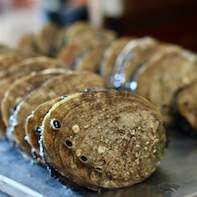
HIK Abalone Farm’s hatchery is divided into four departments: broodstock, larvae, settlement and weaning. The hatchery period from egg to ten millimeter spat takes six months and the hatchery currently produces 6.5 to 7 million spat annually.
The abalone farming process starts with broodstock. Only abalone with superior characteristics are selected as brood animals, and males and females are then separated and housed in a controlled environment.
They are fed kelp, as well as a special blended feed. This process allows for a safe fertilization program, which is strictly monitored to ensure that fertilized eggs are of the highest quality.
After the first few hours of fertilization, a free swimming trochophore larva leaves the egg membrane. These larvae are housed in tanks with filtered seawater, and they are monitored daily. The best quality larvae are chosen in a few days, and are transferred to a settlement.
Once in the settlement their diet consists of micro-algae grown on polycarbonate plates. If adequate, the larvae will attach to the plates, cease any swimming activities and grow into baby abalone (also known as spat). Their food source for the next 4 months will be miro-algae, and they are sorted according to size.
The next stage of the cycle is called weaning. The baby abalone are weaned off their diet of micro-algae and are fed Abfeed. Dedicated workers look after the spat as they rapidly adapt to their new environment. They grow to around 10 mm within a few months, at which point they are strong enough to move on to the next stage of grow-out.
HIK Abalone Farm's abalone grow to market size over a period of 36 – 45 months. The abalone are carefully nurtured in oyster net baskets suspended in tanks, and fed on Abfeed which is specifically prepared and nutritionally composed for the species.
Tanks are cleaned weekly, and optimal energy is focused on animal health and the husbandry process. HIK Abalone Farm’s grow-out tanks currently support in excess of 5 million individual animals.
 South Africa is one of the world’s top producers of abalone, exporting high-quality products of the endemic Haliotis midae or ‘perlemoen...
South Africa is one of the world’s top producers of abalone, exporting high-quality products of the endemic Haliotis midae or ‘perlemoen...